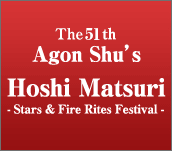
1st 11:15
2nd 12:30
3rd 13:30
4th 14:30
1st 11:50
2nd 14:00
1st 10:15
2nd 11:30
3rd 12:15
4th 12:50
5th 13:15
6th 13:45

The highlights of the day of the ‘Agon Shu’s Hoshi Matsuri’ are introduced here with the course of the day
A total of 600 yamabushi members walk in procession.
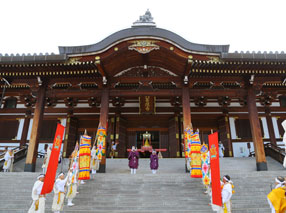
The parties involved enter the Hoshi Matsuri Festival site along with the music, "Hoshi Matsuri Overture" composed by Toshiro Mayuzumi.
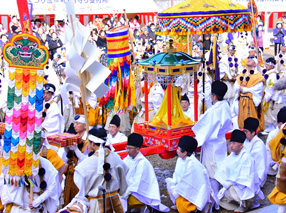
Shinto rituals are conducted, inviting multitudinous gods including Susanoo-no-Mikoto.
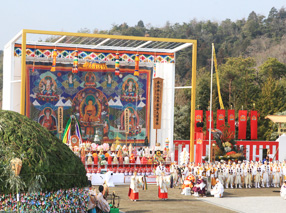
In accordance with tradition, yamabushi members conduct a question and answer session, discussing the heart and essence of Agon Shu’s shugendo (mountain asceticism) and their voices echoing in the mountain.
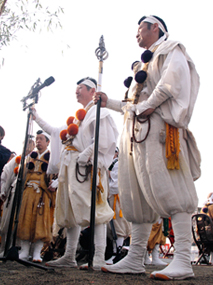
Onosaho is a ceremony to set up and purify the site where the Buddhist memorial service is conducted. It demonstrates the scene, opening the site by cutting through the forest using an axe.
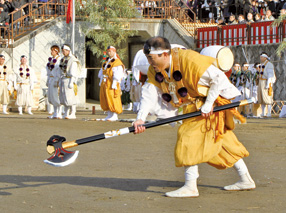
Hokyusaho is a traditional ceremony, representing the scene of setting up the ground where the Buddhist memorial service will be conducted. It is conducted to evacuate evil spirits existing in the universe and purify the site by the movements of fixing arrow to bow.
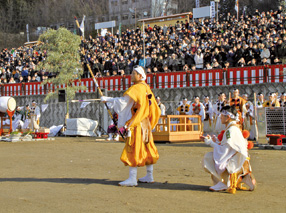
Hokensaho is a ceremony performed to eliminate evil thoughts and worries from people’s minds, and cleanse mind and body with the holy sword, while also purifying the kekkai – the holy sanctuary in which the Buddhist memorial service is conducted.
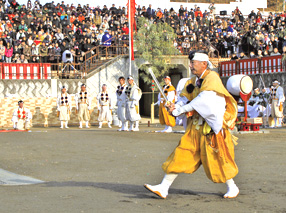
Ganmon, written prayers to the gods and the Buddha, are read by the great spiritual leader. It is a ceremony to bring about the visitors' wishes written on gomagi to fruition. It is held within the Kekkai where everything is purified.
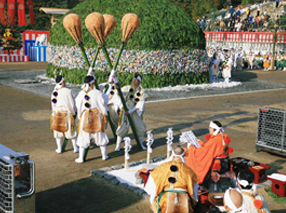
The holy flame of "goma with psychic powers," a treasure of Agon Shu, is transferred to the torches.
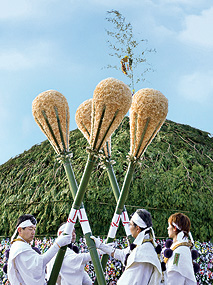
The flame is transferred and lit on the two giant sacred wooden pyres via the torches.
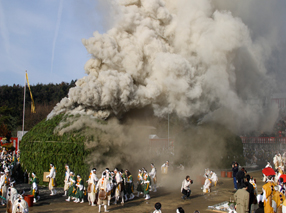
The teachings of Buddhism are dedicated by worshippers.
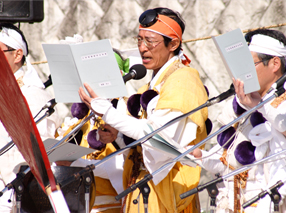
In the Agon Shu’s Hoshi Matsuri, Shinsei Busshari Son or Authentic Buddha’s relics, the principal Buddhist image, and Susanoo-no-Mikoto as the All-father of the Shinto realm, are enshrined on the right and left hand sides of the altar from the observer respectively. Shinkai-dan, or sacred wooden pyre of the Shinto realm for the accomplishment of wishes and Bukkai-dan, or sacred wooden pyre of the Buddhist realm for venerating ancestors, are set up in which a fire rites ceremony dedicated to the gods and the Buddha. It is conducted through the Agon Shu’s unique secret process of Shinto and Buddhist realms by burning gomagi collected from the visitors. During this ceremony, the great spiritual leader Seiyu Kiriyama Kancho conducts special rites and chants nine secret syllables to bring good luck, eliminate harm and work a miracle.
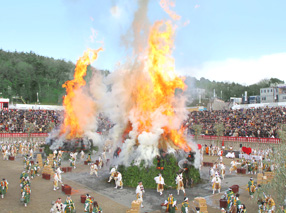
Giant Thanka or Thongdrel, which has been handed down from generation to generation in the Kingdom of Bhutan, possesses great merits. It embodies the greatest secret method of the Buddhism in Bhutan, which is "liberation through seeing." The word Thongdrel means Thong (seeing) and Drel (liberation) and, in a complete Buddhism world, seeing a mandala awakens the buddha nature that sleeps deep within all men that leads them from endless reincarnation to liberation. It is a special and valuable giant mandala. This mandala is exhibited only for several hours once a year in each region of the Kingdom of Bhutan.
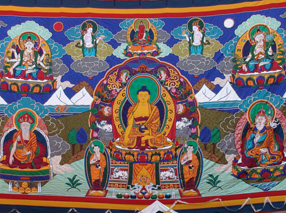
Gomagi is a piece of wood used to pray for one’s wishes and venerate ancestors. The gomagi on which prayers are written will be burned in the holy fire of the giant sacred wooden pyres.
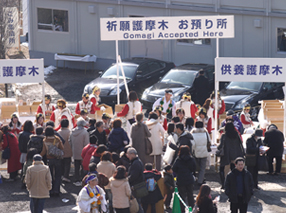
Agon Shu’s unique shugen-daiko is a drum performance, dedicated to the gods and Buddha with the sound of drums. The music performed here is composed and directed by Mr. Roetsu Tosha, a leading kotsuzumi player.
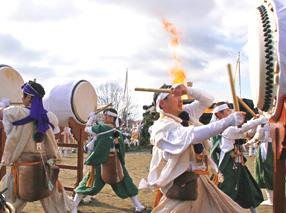
Iyasaka Shinju Gagaku (Japanese traditional court music) is dedicated by Iyasaka Shinju Gagakubu at the Kaguraden in the Temple Square. The musical performance is dedicated with the significance of the Shinto realm of respecting the gods of Japan and venerating ancestors.
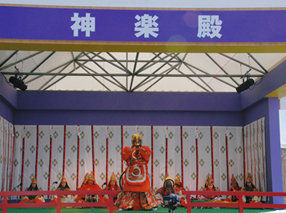
As a brother God of Amaterasu-Oomikami, the Japanese Goddess of the Sun, Susanoo-no-Mikoto is a great God who accomplished the mighty feat of establishing the country of Japan using his stormy power. Please come and visit Susanoo Shrine, where Susanoo-no-Mikoto - who has the power to eliminate any obstacles and disasters - is enshrined. You can pray for protection from negative vibes that cause illness and other misfortune, and for good luck.
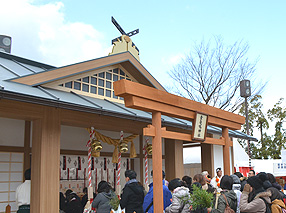
With special permission by White Cloud Temple (Baiyunguan) – the head temple of Chinese Daoism – in Beijing, replicas of the famous secret statues of "Sixty Guardian Deities"(each person has a guardian deity according to his/her year of birth), from White Cloud Temple, are displayed and shown on the day of the Hoshi Matsuri.
The Sixty Chinese Guardian Deities are gods rooted in Daoism and represent the guardian deities of all beings, with each year of birth corresponding to a particular deity, from the year of kinoene to kigai with a sixty-year cycle.
We recommend that you take this opportunity to visit your own guardian deity and make a wish for the help of the god.
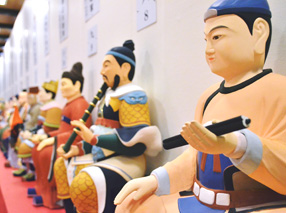
You can see the secret Buddha of Agon Shu only on this day. In addition, this year, the statue of Gyorankannon will be unveiled for the first time.
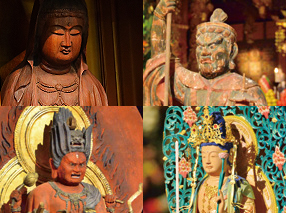
Ever since the Gods Naniwa Ebisu and Naniwa Daikokuten came to Agon Shu, in addition to their power for wealth, they obtained immense power by "Shaka-no-Jobutsu-ho," a religious doctrine to attain Buddhahood by being liberated from earthly desires and achieving enlightenment,. Please visit the shrine to pray and gain great wealth and good luck with the help of the two gods.
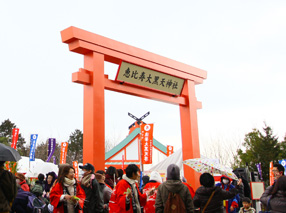
Various buddhas, bodhisattvas and deities with the powerful divine spirit that the Bhutanese Buddhism possesses are enshrined at the Bhutan temple.
Rarely shown Buddhist images and mandalas brought from the Kingdom of Bhutan in the Himalayas are exhibited. Please enjoy your visit in the mysterious atmosphere of the Bhutanese temple.
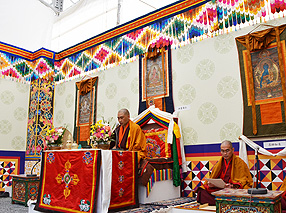
This stupa was built exactly the same as the stupa in Jerusalem, which was built in August 2013, using the exact same materials and shape. In addition, the statue of the Lion of Jerusalem was donated by the guests from Israel, who attended the Hoshi Matsuri in February 2008. This statue is a symbol of Jerusalem and was donated for the friendship between Agon Shu and Israel.
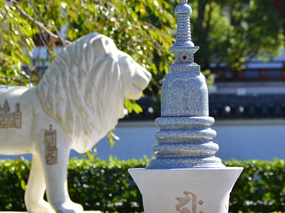
At Agon Pavilion, an introduction to Agon Shu and Agon Shu’s Hoshi Matsuri are offered via a brochure, panel photos and DVD images.
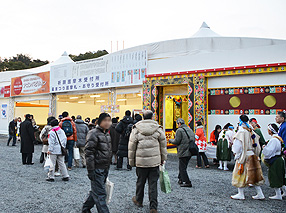
|
|
|
| All manner of things, including romance, career, home and health, can be foretold correctly through Agon Buddhist Astrology. We can show you the way to build a bright future and live a happy life through Agon Buddhist Astrology with an astonishing prediction rate. |
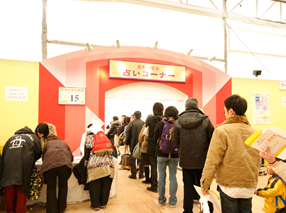
|
|
|
|
| After the ceremony of hibuse (preventing fires), eko or merit transference will be chanted. |
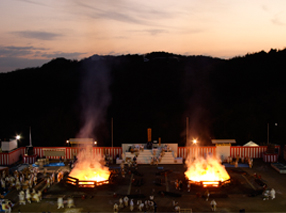
|
|
|
|
| The closing call of the ceremony is heralded by trumpet shells and the end of the Hoshi Matsuri will be announced. |
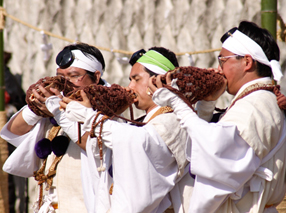
|

